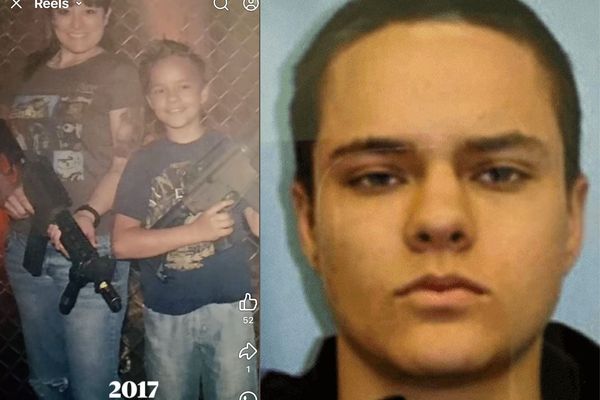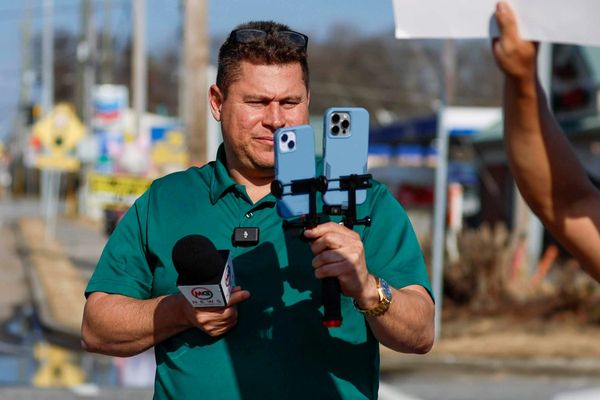
The doctor wasn’t listening. A receptionist had accused her of making things up. The medicine in the chest patch she wore to maintain her cognition made her so nauseous that she went to the hospital. The Rev. Carolyn Habersham had a sermon to deliver at the end of that week, but her brain had been gradually deteriorating. That made the normal few hours of preparation stretch for days. Habersham said it was her week of revelation.
Habersham, who lives in the Hyde Park neighborhood of South Los Angeles, is 72 years old. It was in that week in August that she saw how her fading memory was getting worse. More than a year ago, in September 2023, she had already stopped cooking and driving, activities she recognized had become unsafe for her: She had left pots on a burning stove. She did not want to hurt anyone if she could not remember the rules of the road while behind the wheel. But when she struggled to compose her sermon at the end of this summer, and knew she would not be able to remember it at the pulpit, she saw that she was losing who she was. She also knew who she wanted to become: an advocate for African Americans with dementia.
Habersham’s story is, in many ways, shared with thousands of Black seniors in Los Angeles County. The Los Angeles County Dept. of Public Health predicts the number of African Americans with dementia will grow to more than 35,000 by 2040, up from 14,000 in 2019.
Those numbers make Los Angeles County one of the nation’s Black dementia epicenters. Black seniors, like Habersham, have higher rates of dementia than Latinos and whites — in California and nationally.
When Habersham, a meticulous planner, decided to see a doctor, she knew she would need more than one opinion. She was a cancer survivor, and from her previous experiences she knew doctors often did not listen to her. Research shows doctors are more likely to doubt what Black patients tell them about their condition compared to white patients.
First she saw a neurologist who diagnosed her with mild cognitive impairment. But Habersham felt he was not hearing her when she described just how severely she felt she was declining. She not only forgot where she put things, but also could not recognize normally familiar objects like her mobile phone. The visit was over in less than half an hour.
Habersham said the neurologist told her to just wait, as her brain might heal itself. Habersham had already been reading up on Alzheimer’s and was skeptical. She asked the doctor if there was any evidence of a brain healing itself. The doctor said there was none.
Unsatisfied, Habersham went to an Alzheimer’s support luncheon at the West Angeles Church of God in Christ in the Crenshaw district, where she met a UCLA neuropsychologist who suggested she visit her for more testing.
Habersham took her up on the offer, and after five hours of testing, the neuropsychologist concluded that Habersham’s brain was atrophying in the areas crucial to brain-body communication as well as those that regulate behavior, personality and language.
Habersham said she wants others to learn from her experience. Her message: With whatever mental capacity you have, advocate for yourself. Take what doctors or others tell you seriously, but do your own research. By speaking about her experience at church or directly with individuals on the phone, she guides other Black seniors sorting through their own memory loss and dementia.
Habersham is unusual in embracing her condition as a first step to adapting to it. That’s why I wrote about her this past summer. Now, as her condition becomes more severe, she has even more valuable lessons to share.
In the early stages of memory loss, a person will forget names, the words they meant to use and why they entered a room or what they were looking for. The memory loss makes the person frustrated and scared. They fear losing not just their keys but their independence. Denial is common, preventing early diagnosis and help.
This summer, she saw a second neurologist. That visit took months to arrange as Habersham worked through insurance paperwork, referrals and waiting for the first available appointment. The second neurologist also downplayed her condition. He told her to see a psychotherapist.
Habersham said she could not believe what she was hearing. “You all are practicing legal homicide,” she told him. “How many other people have you sent away who have problems?” she asked.
Then she told the neurologist she had been tested at UCLA and was diagnosed with frontal lobe dementia. His demeanor changed immediately, Habersham said. He asked her why she did not tell him about her UCLA diagnosis. Habersham said she had not brought it up because she was hopeful the neurologist would listen to her and form his own, thoughtful judgment.
After Habersham told him about the severity of her condition, and persuaded him with what she had learned at UCLA, the neurologist sent Habersham to a clinic for additional testing.
The clinic was in Los Angeles’ Florence neighborhood, run out of a building that also houses a storefront church. It was a type of place familiar to Habersham from her years of seeking cancer care without health insurance. She calls them “hood clinics” — understaffed, rundown facilities located in places where people have few, if any, other options.
Habersham entered a waiting room full of people seated and standing. She saw a constant flow of patients in and out of the consulting rooms. She recognized nurses and attendants but no doctors. She said it appeared to be an “insurance mill,” where patients were seen as quickly as possible to make way for the next person. She immediately wanted to leave, but she stayed. A doctor who was not present phoned in and spoke to Habersham, then prescribed a transdermal chest patch with a medicine that can improve thinking ability in some patients — though it will not stop the dementia from getting worse.
When Habersham called the clinic later, she said the receptionist did not have a record of her visit and insisted Habersham had never spoken to a physician there. Habersham responded with the details of her prescription. With that detail, and more urging from Habersham to keep searching her records, the receptionist found that the attendant had not filed notes on Habersham’s visit.
Habersham eventually got what she needed because she was prepared with evidence and willing to push back against dismissive medical staff and doctors. She is concerned that the kinds of patients who rely on “hood clinics” have not been taught to do so. “The patients at that clinic are people who trust doctors. They are not those who advocate for themselves. They are not those who ask questions,” she said.
In September, Habersham spoke at a Black memory loss conference in Inglewood. Petra Niles, a senior manager with Alzheimer’s Los Angeles, a local advocacy group, said Habersham’s testimony encourages people to seek support who might otherwise stay silent for fear or denial.
“In the community, people haven’t seen someone in the early stages of the disease talk about and share their experience,” Niles said.
Dementia isn’t a single disease but an umbrella term for multiple forms of concurrent memory loss, according to the Alzheimer’s Association, a national research and advocacy organization. Alzheimer’s disease is the most common form of dementia.
There is no cure for dementia, but the disease can be slowed with exercise, diet, medicine and early detection. Until patient care is improved, Habersham and others with dementia must schedule and meet with doctors, and social services representatives and manage their own medication and basic necessities, like travel and meals.
The same week of her second neurologist call and clinic visit, Habersham had been invited to Preach-Her-Thon, a revival with other women pastors. This was important to Habersham because she knew her years of preaching would soon end.
The revival would be held at First African Methodist Episcopal Church of Los Angeles, or FAME, one of the most prominent congregations in the city. For Habersham, preaching at FAME was special not only because of its stature, but also because doing so marked a return to the denomination in which she began her ministerial career. While she is now pastor at a Presbyterian church, she began preaching 30 years ago at Emmanuel H.M. Turner AME Church in South Los Angeles.
Thus began that fateful week of revelation. Habersham planned to preach about a passage from the Gospel of Luke: the story of a sick woman who touched Jesus’ robe to be healed. Habersham has a painting of the scene hanging in her living room.
But she struggled to prepare her sermon. Habersham normally prepared her sermons by starting in the morning by reading the short Bible passage it would be built around, to connect it to the message of the sermon. She would typically finish the same day. This time she forgot within minutes the ideas she wanted to connect. It took her so much energy to stay focused that she had to quit before the afternoon.The process stretched for days. She then realized she would need to read from a script, which she had never done previously.
The difficulty reminded her of her father, Ezekiel, also a preacher, who died in 2013. He had Alzheimer’s disease. As the disease progressed, her father became petrified of preaching, she recalled. As his condition worsened, he rambled at the pulpit. Habersham knew she would soon have to give up preaching.
There was something more.
“The hardest part of that sermon was being vulnerable and open with everybody,” she said. People understand cancer, she explained. They are aware of its treatments, and they know cancer survivors.
“People look at you different when you say ‘dementia,’” Habersham said. Alzheimer’s and dementia have no cure, which makes people uncomfortable talking about it. Particularly in Black communities, awareness of the disease is limited and misconceptions are common. She didn’t know how congregants would react to her admission that she has the disease.
She had always expected she would know well in advance when she would deliver her last sermon, giving her time to prepare herself emotionally and invite loved ones. Dementia robbed her of that time. She began inviting those closest to her to her final sermon the day before.
When it was time to deliver her sermon, the bright lights kept her from seeing the people she faced from the altar. But she looked up to the second floor, and saw a trio of silhouettes looking down. A great peace came over her.
“The miracle of that service was me being able to look up and see the outline of my son and grandsons in the balcony,” Habersham said.
Two days later, she was back in a hospital. The prescription made her sick again. Habersham has found a third neurologist in Pasadena. She has been waiting since September for the first available appointment. While she remains hopeful this neurologist will be supportive, Habersham will arrive prepared for whatever might arise. She now has the knowledge gained from her experiences as a Black patient and what she has learned from test results and doctors’ notes from her previous treatment. She also has the will to demand dignified aid for herself and others with dementia. Whatever happens, other Black people with dementia, caregivers and I will continue to learn from Habersham.







